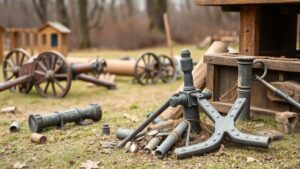Essential Tips for Beginner Metal Detecting Enthusiasts
Essential Tips for Beginner Metal Detecting Enthusiasts
Metal detecting is a rewarding hobby that combines outdoor adventure with the thrill of discovery. As a beginner, navigating the complexities of this pursuit can be daunting. But, by equipping yourself with essential knowledge and skills, you can enhance your experience and increase your chances of finding valuable treasures. This article outlines crucial tips for novice metal detectorists, touching upon the equipment, techniques, and locations, complemented by practical examples and relevant statistics.
Choosing the Right Metal Detector
The first step for any beginner is selecting an appropriate metal detector. With an array of options available, understanding the basic types can help you make an informed choice. Broadly, metal detectors fall into three categories: VLF (Very Low Frequency), PI (Pulse Induction), and BFO (Beat Frequency Oscillation).
- VLF Detectors: These are the most popular among hobbyists due to their versatility and user-friendliness. are effective for coin shooting and relic hunting. For example, the Garrett ACE series is a well-regarded choice, balancing cost and performance.
- PI Detectors: More powerful, these detectors excel in finding buried treasures at greater depths, making them suitable for saltwater beach hunting. But, they tend to be pricier and less suited for general use.
- BFO Detectors: While generally less effective than VLF detectors, BFO units can still be good for beginners on a budget.
Research indicates that the right detector can make a significant difference. For example, a 2021 survey of metal detectorists found that beginners using a VLF unit reported a 30% higher success rate in finding coins compared to those using less sophisticated models.
Understanding Your Equipment
Once you have chosen your metal detector, familiarize yourself with its components and features. Understanding the functionality of the control panel, sensitivity settings, and discrimination options can greatly enhance your detecting capabilities. Most detectors come with a user manual, but there are also numerous online resources, including tutorial videos and forums, that offer in-depth guides.
- Control Settings: Learn to calibrate the settings according to your detecting environment. For example, reducing sensitivity in highly mineralized soils can improve performance.
- Discrimination: This feature helps filter out unwanted objects. For a beginner, setting the discrimination to eliminate iron can prevent frustration in trash-laden areas.
Real-world application indicates that veterans often cite mastering these settings as a turning point in their detecting success, particularly in challenging environments.
Finding the Right Locations
Your success in metal detecting largely depends on the locations you choose. Some of the best spots to start include:
- Historical Sites: Parks, old battlefields, and towns are often treasure troves of coins and artifacts. For example, an amateur detectorist in Gettysburg, Pennsylvania, discovered a remarkable Civil War-era button.
- Beaches: Areas near the water attract vacationers who may lose their valuables. During a busy season, a beach can yield numerous coins and jewelry items.
- Private Property: With permission, detecting on private land that has historical significance can also lead to exciting finds.
Statistics from the National Association of Metal Detectorists reveal that nearly 60% of participants found their best items in parks and recreational areas. Hence, targeting such locations during your outings can maximize your chances of success.
Developing Searching Techniques
Effective searching techniques are critical in maximizing your finds. One proven approach involves using a grid pattern while sweeping the detector. This method ensures complete coverage of an area, minimizing missed targets.
- Slow and Steady: Move your detector slowly to allow it to pick up signals accurately. Quick movements can result in missed signals.
- Overlap Sweeps: Keep your swings slightly overlapping to ensure that you cover every square inch of the area.
Further, consider the angle of your swings. Swinging from left to right, then back can provide a broader detection range and increase the likelihood of detecting deeper targets.
Investing in Proper Accessories
While a metal detector is the primary tool, various accessories can significantly enhance your detecting experience. Essential accessories include:
- Headphones: Quality headphones can help you hear faint signals, especially in noisy environments.
- A Digging Tool: A sturdy trowel or spade is essential for retrieving items from the ground without causing damage.
- Pouch or Backpack: A pouch for holding finds and a waterproof backpack can help keep your items organized and protected.
Investing in these accessories not only improves efficiency but also enhances the overall enjoyment of the metal detecting experience.
Respecting Legal and Ethical Guidelines
Metal detecting comes with responsibilities. Familiarize yourself with local laws regarding treasure hunting, particularly concerning permissions and reporting finds. It is vital to respect private property and historical sites.
- Obtain Permission: Always seek permission before detecting on private land. Not doing so can lead to legal consequences.
- Follow The Treasure Hunters Code: This code advises leaving the location as you found it, filling in any holes you dig and not leaving trash behind.
Respect for the environment and the history of the land is fundamental to maintaining a positive image for the hobby. Many clubs and organizations work towards promoting ethical detecting practices, which can serve as valuable resources for beginners.
Conclusion and Actionable Takeaways
Beginning your journey in metal detecting is both exciting and challenging. By equipping yourself with the right knowledge, equipment, and techniques, you can significantly increase your chances of success. Here are some actionable takeaways:
- Select a beginner-friendly VLF metal detector that suits your specific interests.
- Fully understand the operational features of your detector.
- Research and target promising locations known for historical significance.
- Employ effective searching techniques to maximize your finds.
- Invest in essential accessories for an enjoyable and efficient detecting experience.
- Always adhere to legal and ethical guidelines in your metal detecting pursuits.
By following these tips, you will enhance your experience in the field and may uncover unexpected treasures, making for a fulfilling hobby. Happy detecting!


